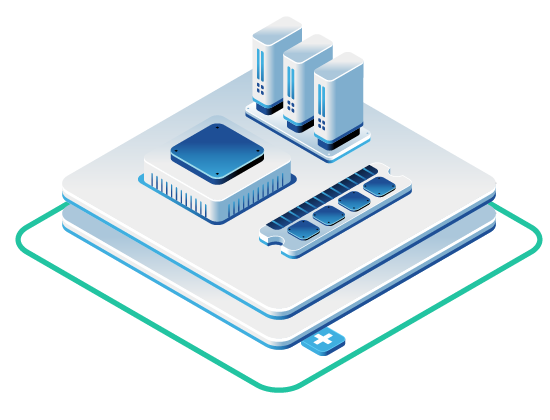Protecting OpenStack Networking helps avoid data breaches and supports reliable cloud operations. Here’s a quick overview of the strategies we’ll go over in this guide:
- Network Separation: Use VLANs or VXLANs to isolate traffic and prevent cross-tenant interference.
- Access Controls: Configure Neutron security groups to allow only necessary traffic and restrict unauthorized access.
- API Protection: Secure API endpoints with SSL, IP restrictions, and rate limiting.
- Traffic Monitoring: Use tools like the ELK stack or ntopng to log and analyze network activity for potential threats.
Using multiple layers of security protects OpenStack environments from risks like DDoS attacks, traffic interception, and cross-tenant breaches.
How secure is OpenStack as a whole?
OpenStack’s security is a shared responsibility. The cloud provider (e.g., OpenMetal) is responsible for securing the underlying infrastructure, including the physical hardware, network, and hypervisor.
The user, on the other hand, is responsible for securing their own instances and applications running within OpenStack. This includes configuring security groups, managing access controls, patching vulnerabilities, and implementing appropriate security measures within their virtual machines.
OpenStack provides a rich set of security features, but it’s up to the user to configure and use these features effectively. Regular security assessments, penetration testing, and vulnerability scanning are needed to maintain a secure OpenStack environment.
For those using hosted solutions like OpenMetal, these services add extra safeguards, including things like tenant isolation, encrypted data handling, and managed security updates.
Now let’s get into how you can better secure the networking functionality of OpenStack.
Video: Securing OpenStack Networking
Network Separation Methods
Network segmentation is fundamental to OpenStack security. Two primary technologies are used for this: VLANs and VXLANs.
VLANs (Virtual Local Area Networks) operate at Layer 2 of the OSI model and are used to segment physical networks. They offer a maximum of 4,096 distinct networks.
VXLANs (Virtual Extensible LANs), on the other hand, are overlay networks that encapsulate Layer 2 traffic within UDP packets (Layer 3). This allows for network virtualization and enables the creation of isolated networks across a shared physical infrastructure. VXLANs significantly expand the number of available network segments (up to 16 million) and are important in multi-tenant environments.
While both achieve network isolation, VLANs are traditionally used for physical network segmentation within a data center, while VXLANs are designed for overlay networks, often spanning multiple physical locations or cloud environments. GRE (Generic Routing Encapsulation) was previously used for similar overlay functionality but VXLAN is now preferred due to its scalability and other advantages.
The choice between VLANs and VXLANs depends on the specific requirements of your OpenStack deployment. For example, VLANs may be suitable for smaller deployments with limited segmentation needs, while VXLANs are a better fit for larger, multi-tenant clouds.
VLAN and Overlay Configuration
Choose VLANs (up to 4,096 segments) for workloads that need high performance, or opt for VXLAN/GRE (up to 16 million segments) for large-scale isolation needs. Use the following configurations based on your requirements:
VLAN Configuration Example:
[ml2]
type_drivers = vlan
tenant_network_types = vlan
[ml2_type_vlan]
network_vlan_ranges = physnet1:1000:2000
VXLAN Configuration Example:
[ml2]
type_drivers = vxlan
tenant_network_types = vxlan
[ml2_type_vxlan]
vni_ranges = 1:1000
[vxlan]
local_ip = 192.168.1.10
| Network Type | Maximum Segments |
|---|---|
| VLAN | 4,096 |
| VXLAN | 16 million |
| GRE | 16 million |
ML2 Plugin Configuration
The Modular Layer 2 (ML2) plugin is a core component of Neutron, responsible for managing the interaction between OpenStack networking and the underlying network infrastructure. The type_drivers parameter specifies which network types are supported (e.g., flat, vlan, vxlan). The tenant_network_types parameter indicates the network types available to tenants. The mechanism_drivers parameter lists the drivers used to interact with the physical or virtual network infrastructure (e.g., openvswitch, linuxbridge).
Here is an example configuration:
[ml2]
type_drivers = vlan,vxlan
tenant_network_types = vxlan
mechanism_drivers = openvswitch,l2population
Use this to segment the network into distinct planes:
- Management Network: VLAN 100, 192.168.1.0/24 (dedicated to administrative tasks)
- Storage Network: VLAN 200, 192.168.2.0/24 (keeps data plane traffic separate)
- Tenant Networks: VXLAN, 10.0.0.0/8 (isolates tenant workloads and prevents cross-tenant interference)
In this example, we’ve enabled VLAN and VXLAN support. The l2population mechanism driver is often used with VXLANs to optimize Address Resolution Protocol (ARP) handling. l2population helps distribute ARP information across the VXLAN overlay network, reducing broadcast traffic and improving performance.
It’s important to understand the implications of different network types. flat networks, while simple to configure, offer no isolation between instances. All instances on a flat network share the same broadcast domain, making them vulnerable to security risks. Therefore, flat networks are generally not recommended for production deployments and should only be used in controlled environments, such as for testing or development. VLANs provide basic Layer 2 isolation, while VXLANs offer the most advanced isolation, especially in multi-tenant cloud environments.
Verifying Network Separation
To confirm that the network separation is configured correctly, run these commands:
openstack network list
ovs-vsctl show
Check the output for distinct network IDs and ensure VLAN or VXLAN tags align with your configurations. This will help confirm that isolation is functioning as intended.
Security Groups and Firewalls
Once you’ve set up network separation, it’s time to enforce access controls using security groups and firewalls. These tools help manage and restrict traffic at a more detailed level.
Configuring Neutron Security Groups
Neutron security groups act as virtual firewalls for instances, allowing you to define granular rules that control inbound and outbound traffic. When configuring security group rules, the principle of least privilege should always be followed. This means only opening the ports and protocols that are absolutely necessary for the instance to function. Avoid opening wide ranges of ports or allowing traffic from any source (0.0.0.0/0) unless absolutely required.
Carefully consider the specific needs of each instance and create security group rules to match. For example, a web server might need ports 80 (HTTP) and 443 (HTTPS) open, while a database server might only require port 3306 (MySQL) to be accessible from specific IP addresses. Regularly review and update security group rules to ensure they remain aligned with your security policies and application requirements.
Here’s a configuration example:
# Create a security group for web servers
openstack security group create web_servers --description "Rules for web server instances"
# Add rules for HTTP, HTTPS, and limited SSH access
openstack security group rule create --protocol tcp --dst-port 80 --remote-ip 0.0.0.0/0 web_servers
openstack security group rule create --protocol tcp --dst-port 443 --remote-ip 0.0.0.0/0 web_servers
openstack security group rule create --protocol tcp --dst-port 22 --remote-ip 192.168.1.0/24 web_servers
These rules ensure that web servers are accessible on HTTP/HTTPS while restricting SSH access to a specific subnet.
Implementing FWaaS (Firewall-as-a-Service)
Firewall-as-a-Service (FWaaS) provides network-wide firewalling capabilities in OpenStack. FWaaS v2 allows you to define firewall rules, policies, and groups, which can be applied to router interfaces. While the examples provided use the iptables driver, FWaaS can utilize different backend implementations. The choice of backend depends on your specific requirements and infrastructure. It’s important to consult the OpenStack documentation for information on supported FWaaS drivers and their configuration.
Here’s how to set FWaaS up:
1. Enable FWaaS v2 in neutron.conf:
[service_providers]
service_provider = FIREWALL:fwaas_db:neutron.services.firewall.drivers.linux.iptables_fwaas_v2.IptablesFwaasDriver:default
2. Update the l3_agent.ini file:
[AGENT]
extensions = fwaas_v2
3. Create firewall rules, policies, and groups:
# Define a firewall rule
openstack firewall group rule create --protocol tcp --destination-port 80 --action allow web_access
# Create a firewall policy and add the rule
openstack firewall group policy create web_policy
openstack firewall group policy insert rule web_policy web_access
# Create and apply a firewall group
openstack firewall group create --ingress-firewall-policy web_policy --egress-firewall-policy web_policy web_firewall
Key Features of FWaaS
| Feature | Description |
|---|---|
| Port-Level Control | Apply rules to specific router or VM ports. |
| Policy Separation | Manage ingress and egress policies separately. |
| Granular Rules | Set detailed L3 firewalling for router ports. |
| Scalability | Handle multiple firewall groups effectively. |
Using both security groups and FWaaS creates a layered defense, strengthening your network. This approach works hand-in-hand with API protections, which we’ll discuss next.
API and Service Protection
Once instance-level firewalls are in place, the next step is to secure API endpoints and service communications. Beyond IP restrictions and SSL/TLS encryption, consider implementing an API gateway.
An API gateway can provide additional layers of security, such as authentication, authorization, rate limiting, and input validation. It can also simplify API management and monitoring. API gateways can help protect against common API attacks, such as denial-of-service attacks, brute-force attacks, and injection attacks. Do remember to regularly audit API access logs to detect any suspicious activity.
Neutron IP Restrictions
Restricting API access by IP adds another layer of security. You can configure the neutron.conf file to bind the service to specific network interfaces:
[DEFAULT]
bind_host = 192.168.1.10
bind_port = 9696
use_ssl = True
Additionally, use iptables to control access:
# Allow access only from the management network
iptables -A INPUT -p tcp -s 192.168.1.0/24 --dport 9696 -j ACCEPT
# Block all other requests to the API port
iptables -A INPUT -p tcp --dport 9696 -j DROP
SSL and RPC Encryption
Enabling SSL/TLS encryption for API and RPC communication protects sensitive data in transit. However, simply enabling SSL is not enough. Use strong ciphers and keep your SSL certificates up-to-date. Weak ciphers can be vulnerable to attacks, compromising the confidentiality of your data.
Regularly check for and install security updates to address any known vulnerabilities in SSL/TLS implementations. Consider using a certificate management system to automate the process of certificate renewal and avoid certificate expiration issues.
Here’s how to configure SSL encryption:
# API SSL Configuration
[DEFAULT]
use_ssl = True
ssl_cert_file = /path/to/cert.pem
ssl_key_file = /path/to/key.pem
# RPC Encryption
[oslo_messaging_rabbit]
rabbit_use_ssl = True
rabbit_ssl_ca_file = /path/to/ca.pem
rabbit_ssl_cert_file = /path/to/cert.pem
rabbit_ssl_key_file = /path/to/key.pem
To further secure these endpoints, enable API rate limiting in your setup:
[DEFAULT]
api_rate_limit = True
Network Traffic Management
Once API endpoints are secured, the next step is monitoring network traffic to spot potential threats. This completes a multi-layered security approach. Using centralized logging can additionally help cut down incident response times.
Setting Up Central Logging
Centralized logging is a major factor within a comprehensive security strategy. Collecting logs from various OpenStack services (Neutron, Nova, Cinder, etc.) into a central location makes it easier to analyze and correlate security events.
Log aggregation and analysis tools, such as the ELK stack (Elasticsearch, Logstash, Kibana) or Graylog, are ideal for this. These tools allow you to search, visualize, and analyze logs, helping you identify suspicious patterns and potential security breaches.
Consider implementing a Security Information and Event Management (SIEM) system to further enhance your log analysis capabilities. A SIEM can correlate events from multiple sources, detect anomalies, and generate alerts for security incidents. Ensure your logging configuration captures all relevant security events, including authentication attempts, API calls, security group changes, and firewall rule modifications.
To configure Neutron logging, edit the /etc/neutron/neutron.conf file. Tools like the ELK stack or Graylog are commonly used for this purpose:
[DEFAULT]
debug = False
use_syslog = True
syslog_log_facility = LOG_LOCAL0
Focus on logging these high-priority network events:
- Changes to security groups
- Modifications in firewall rules
- Unusual traffic patterns or sudden volume increases
- API calls related to network configurations
- Failed authentication attempts for network services
For deeper visibility, deploy flow collectors like ntopng with Open vSwitch (OVS) integration. Here’s how you can set it up:
apt install ntopng
systemctl enable ntopng
ovs-vsctl -- --id=@sflow create sflow agent=eth0 \
target=\"127.0.0.1:6343\" header=128 sampling=64 \
polling=10 -- set bridge br-int sflow=@sflow
While ntopng is a useful tool for network traffic analysis, other tools can also be valuable. tcpdump is a command-line packet capture utility that allows you to capture network traffic for detailed analysis. Wireshark is a powerful graphical packet analyzer that can be used to dissect and inspect captured packets. These tools can be used in conjunction with flow collectors like ntopng to provide a full view of network traffic. sFlow is a sampling technology that provides visibility into network traffic at a lower overhead than full packet capture. It’s a good fit for high bandwidth environments.
Summary
Protecting OpenStack networking requires multiple layers of security: isolation, access controls, encryption, and monitoring. This approach aligns with OpenStack’s principle of layered defense.
At the instance level, security groups enforce specific rules, while FWaaS (Firewall-as-a-Service) applies policies across the network, working together to block unwanted traffic. Administrators should use strong authentication measures to secure API endpoints.
Consistency is key to making these layers effective. For teams looking for production-ready solutions, OpenMetal’s hosted platform offers tools to manage traffic and monitor security events in real time. Managed private cloud platforms add extra protection with customizable settings and expert-maintained deployments, reducing the burden of handling everything in-house.
Staying secure with OpenStack also means keeping up with updates and addressing new threats. Regular penetration testing can help uncover vulnerabilities before they become a problem.
Read More on the OpenMetal Blog


































